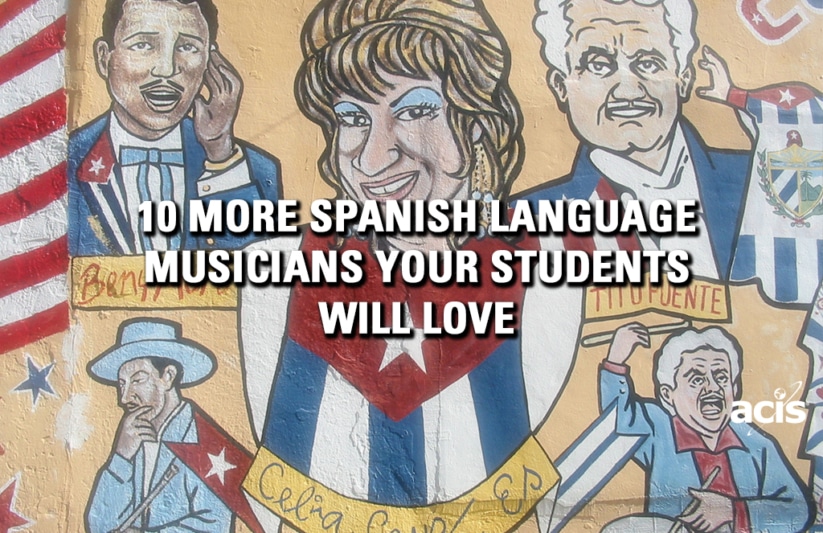Spanish Language Resources: 10 More Spanish Language Musicians Your Students Will Love

In June, we published our first edition of 10 Spanish Language Musicians Your Students Will Love. We sought to shine a spotlight on some musicians that will engage and entertain your students while revealing aspects of Spanish and Latin American culture. We knew then we were only skimming the surface of what’s out there, so we’ve gone back to the drawing board and compiled another list of 10 musicians your students will love.
Listening to music in Spanish is a fantastic and fun way to learn the Spanish language and gain insight into Spanish and Latin American culture.
It’s a great way to connect what your students are learning in the classroom with the culture of the Spanish-speaking world. It’s also a fun way to soak up even more Spanish in between classes!
As we said last time, this is by no means an exhaustive list, but here are 10 More Spanish Language Musicians Your Students Will Love:
-
-
Gondwana – Chile
Similar to Latin Reggae acts, like Los Cafres from Argentina and Cultura Profética from Puerto Rico, Godwana put their own spin on the genre popularized by Jamaican artists over the years. Formed during the Pinochet regime in 1987, the band kept a low profile to avoid persecution from the government until they released their debut album in 1996. Their second album launched them to international stature and dove headfirst into the political issues encountered during the oppressive years of the dictatorship. Their music is easy to listen to and their lyrics are easy to understand, making them a perfect choice for language learners.
-
Celia Cruz – Cuba
An icon of Latin music, Cuban songstress Celia Cruz was one of 14 children born to a family in Barrio Santos Suarez, Havana. Stories of her legendary voice go far back into her childhood where she was given her first pair of shoes by a tourist who she impressed with her singing. She was introduced to the world of professional music by her aunt. She took her to nightclubs and cabarets, which inspired her to pursue a career in show business.
Celia studied at Cuba’s Conservatory of Music in 1947 and went on to join the band la Sonora Matancera in 1950. The group was revered as the Latin equivalent of the Duke Ellington Orchestra and went on to tour the world. After the Cuban revolution, she stayed in the US and became an American citizen. She eventually left the band to pursue a solo career that earned her Grammy nominations and dozens of other awards and accolades.
-
Los Planetas – Spain
For the indie rockers in your classroom, Los Planetas from Granada, Spain, are sure to please. Their later work includes influences like Flamenco and other musical genres commonly associated with Spain, but their early releases are almost exclusively influenced by the American 90’s alt rock scene. Their rise in popularity brought forth an indie rock scene in Spain thereafter.
-
Ana Tijoux – Chile
Born in France to two Chilean exiles—who left during the rise of the oppressive Pinochet regime—Ana Tijoux began to rap and dance at the age of 11. After moving back to Chile in 1993, she went on to pursue a career as a rapper and singer. She blended genres that hearken back to her Chilean roots and broke new ground into contemporary sounds. Her music is known for being unafraid to confront social injustice and her commitment to nonviolence.
-
Enrique Iglesias – Spain/Miami
Many think of him as the mysterious and handsome pop-star who only uses his Spanish ethnicity to heighten his appeal. However, his first five albums were all recorded in Spanish (and he’s released several more after his initial English-language debut). Born in Madrid, his father, Julio Iglesias, was a famous singer in his own right. Enrique hid his musical aspirations from his parents until he signed his first record contract at the age of 20. He then went on to become one of the top-selling Spanish-language musicians the world has ever seen before crossing over into English-language pop.
-
Bomba Estereo – Columbia
Bomba Estereo is a Colombian group based in Bogota that weds tropical, cumbia, vallenato, and champeta rhythms to electro, reggae, and pop in a unique form of dance music. The group was formed by Bogotá native Simón Mejía, along with collaborations. This included a suite of Columbian artists including singer/rapper Liliana “Li” Saumet. This pair remains the band’s central members. Their music gained a global audience by garnering acclaim from MTV Iggy and other contemporary outlets. The up-tempo, electronic sound makes them a compelling listen to audiences of all ages.
-
Marc Anthony – New York/Puerto Rico
The biggest-selling salsa artist of all time, Marco Antonio Muñiz (known across the world as Marc Anthony) is a multi-talented artist. He pursued a career in acting as well as music, philanthropy, entrepreneurship and politics. Born to Puerto Rican immigrants in New York City, Anthony started his career as a backup singer and songwriter in the late 80’s. He went to debut under his own name in 1992. He’s since gone on to sell over 12-million records and win multiple Grammy’s with 25 Billboard Chart hits.
-
Los Fabulosos Cadillacs – Argentina
Hailing from Buenos Aires, Los Fabulosos Cadillacs have been thrilling audiences with their eclectic mixture of rock, rap, ska, reggae, and traditional South American sounds for over ten years. The nine-piece band began in 1985 and chose the name Los Fabulosos Cadillacs, because they liked the sound of it. They went on to win a Grammy in 1998 and had their music featured in several feature films in the United States. They’re known for their irreverent and humorous lyrics, which often contain political undertones.
-
Héctor Lavoe – Puerto Rico
Known as “El Cantante de los Cantantes,” Héctor Lavoe was born in Ponce, Puerto Rico in 1946. He dropped out of music school and left his native land at the age of 17. Lavoe pursued a career in New York City as the salsa era was just beginning. Under the tutelage of legendary salsero Willie Colón, Lavoe went on to went on to become one of the biggest stars of the era. When Colón stepped down from the bandstand he left Lavoe in charge. Life as a solo star was difficult for him as personal trials and tribulations caught up, but his legendary talent was never disputed.
-
Carla Morrison – Mexico
Born in Tecate, Mexico near the California border, Carla Morrison had a passion for the arts from a young age. She moved to Arizona to go to music school, but realized her passion for music was more spiritual than academic. She dropped out and went on to become an accomplished singer/songwriter both as a collaborator and solo artist. Carla won a pair of Latin Grammys in 2012 for her album Déjenme Llorar, which went Gold in Mexico.
-
What Spanish-language musicians do you listen to or recommend to your students? Let us know in the comments section below!










